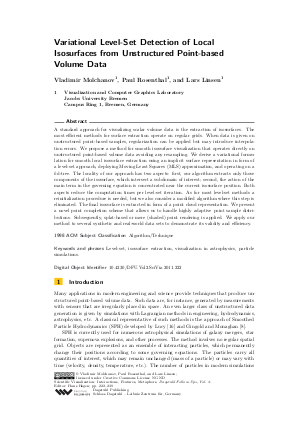Variational Level-Set Detection of Local Isosurfaces from Unstructured Point-based Volume Data
Authors Vladimir Molchanov, Paul Rosenthal, Lars Linsen
-
Part of:
Volume:
Scientific Visualization: Interactions, Features, Metaphors (DFU - Vol. 2)
Part of: Series: Dagstuhl Follow-Ups (DFU) - License:
 Creative Commons Attribution-NonCommercial-NoDerivs 3.0 Unported license
Creative Commons Attribution-NonCommercial-NoDerivs 3.0 Unported license
- Publication Date: 2011-10-26
File

PDF
DFU.Vol2.SciViz.2011.222.pdf
- Filesize: 0.61 MB
- 18 pages
Document Identifiers
Subject Classification
Keywords
- Level-set
- isosurface extraction
- visualization in astrophysics
- particle simulations
Metrics
- Access Statistics
-
Total Accesses (updated on a weekly basis)
0PDF Downloads0Metadata Views
Abstract
A standard approach for visualizing scalar volume data is the extraction of isosurfaces. The most efficient methods for surface extraction operate on regular grids. When data is given on unstructured point-based samples, regularization can be applied but may introduce interpolation errors. We propose a method for smooth isosurface visualization that operates directly on unstructured point-based volume data avoiding any resampling. We derive a variational formulation for smooth local isosurface extraction using an implicit surface representation in form of a level-set approach, deploying Moving Least Squares (MLS) approximation, and operating on a kd-tree. The locality of our approach has two aspects: first, our algorithm extracts only those components of the isosurface, which intersect a subdomain of interest; second, the action of the main term in the governing equation is concentrated near the current isosurface position. Both aspects reduce the computation times per level-set iteration. As for most level-set methods a reinitialization procedure is needed, but we also consider a modified algorithm where this step is eliminated. The final isosurface is extracted in form of a point cloud representation. We present a novel point completion scheme that allows us to handle highly adaptive point sample distributions. Subsequently, splat-based or mere (shaded) point rendering is applied. We apply our method to several synthetic and real-world data sets to demonstrate its validity and efficiency.
Cite As Get BibTex
Vladimir Molchanov, Paul Rosenthal, and Lars Linsen. Variational Level-Set Detection of Local Isosurfaces from Unstructured Point-based Volume Data. In Scientific Visualization: Interactions, Features, Metaphors. Dagstuhl Follow-Ups, Volume 2, pp. 222-239, Schloss Dagstuhl – Leibniz-Zentrum für Informatik (2011)
https://doi.org/10.4230/DFU.Vol2.SciViz.2011.222
BibTex
@InCollection{molchanov_et_al:DFU.Vol2.SciViz.2011.222,
author = {Molchanov, Vladimir and Rosenthal, Paul and Linsen, Lars},
title = {{Variational Level-Set Detection of Local Isosurfaces from Unstructured Point-based Volume Data}},
booktitle = {Scientific Visualization: Interactions, Features, Metaphors},
pages = {222--239},
series = {Dagstuhl Follow-Ups},
ISBN = {978-3-939897-26-2},
ISSN = {1868-8977},
year = {2011},
volume = {2},
editor = {Hagen, Hans},
publisher = {Schloss Dagstuhl -- Leibniz-Zentrum f{\"u}r Informatik},
address = {Dagstuhl, Germany},
URL = {https://drops.dagstuhl.de/entities/document/10.4230/DFU.Vol2.SciViz.2011.222},
URN = {urn:nbn:de:0030-drops-32941},
doi = {10.4230/DFU.Vol2.SciViz.2011.222},
annote = {Keywords: Level-set, isosurface extraction, visualization in astrophysics, particle simulations}
}
